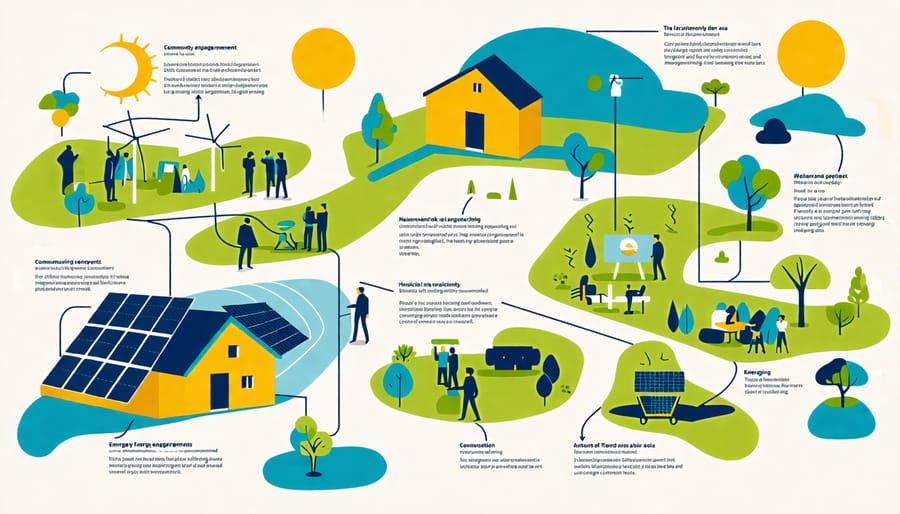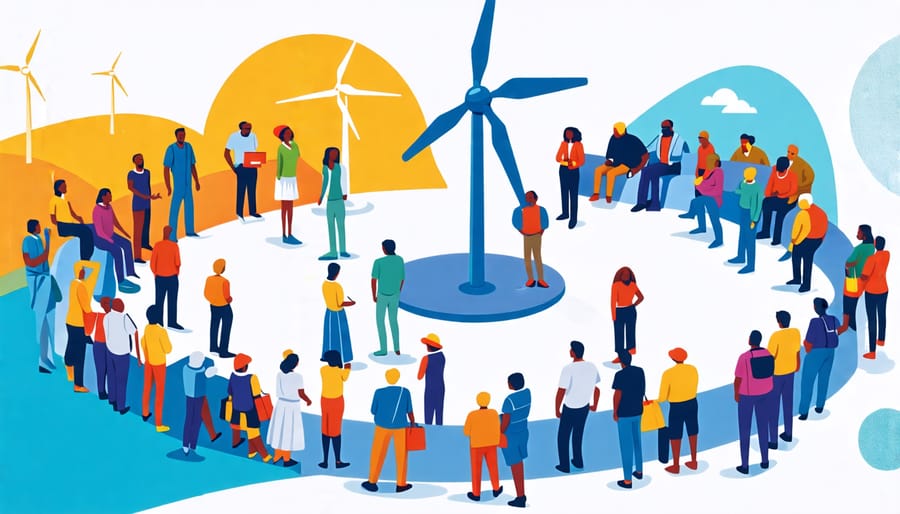Foster a sense of ownership by involving community members in the planning and decision-making processes of renewable energy projects. Educate the public on the benefits and logistics of wind energy through workshops and informational sessions led by industry experts to build trust and understanding. Leverage local success stories and case studies to showcase tangible benefits and encourage buy-in from hesitant stakeholders. Develop partnerships with local educational institutions to create programs for students and adults alike, ensuring sustainable energy literacy and boosting future community leaders in renewable initiatives.
Understanding Community Dynamics
Community Stakeholders
Community stakeholders play a crucial role in the success of renewable energy initiatives, particularly in wind energy projects. Key stakeholders include local residents, who are primarily concerned with environmental impact and potential job opportunities. They seek assurance that projects will not adversely affect their surroundings and that they will benefit economically. Local governments are interested in how these initiatives can contribute to regional development and align with sustainability goals. Educators and schools may look to these projects as hands-on learning opportunities, enriching curricula with real-world applications. Renewable energy companies are stakeholders keen on fostering positive community relations to ensure project support and compliance with local regulations. By understanding and addressing these varied interests, renewable energy projects can foster collaboration and enhance community buy-in for a sustainable future.

Local Culture and Energy Needs
Understanding local culture and regional factors is essential in shaping energy strategies that communities can embrace. Cultural traditions often dictate the pace and type of energy solutions adopted, as seen in rural parts of India, where solar initiatives respect and blend with traditional customs and daily routines. Regional determinants, such as natural resources and geographic conditions, also play a pivotal role. Wind energy might flourish in areas like Denmark due to favorable coastal winds, showcasing how localized conditions can drive renewable choices. Engaging communities requires recognizing these nuances; listening to local voices and incorporating cultural values strengthen project acceptance and success. By aligning energy solutions with local realities, policymakers and educators can foster a collaborative environment rich with enthusiasm for sustainable transformations.
Effective Strategies for Engagement
Educational Workshops and Events
Educational workshops and events are potent tools for building community understanding and support around renewable energy projects. By hosting events that explain the benefits and mechanics of technologies like wind turbines, communities not only gain knowledge but also empowerment to make informed decisions. These gatherings can range from interactive workshops, where participants engage with renewable energy concepts through hands-on activities, to forums that invite dialogue between experts and community members.
One successful example is the Green Community Initiative in Portland, which employed a series of workshops to demystify the concepts of solar vs wind energy. Such initiatives create a platform for open dialogue and collaborative problem-solving, ultimately fostering a positive attitude towards renewable energy projects. By showcasing real-life case studies and including expert interviews, these events ensure that complex topics become relatable and engaging, turning challenges into opportunities for community collaboration and progress.

Leveraging Digital Platforms
Digital platforms have become integral in fostering community engagement, especially in advancing renewable energy initiatives. By using social media channels, online forums, and interactive webinars, communities can connect seamlessly, allowing environmentally conscious individuals and policy-makers to exchange ideas and insights. These tools enable real-time communication and broaden participation, overcoming geographical and temporal barriers.
For instance, a wind energy project in Denmark utilized a digital platform to involve local residents in the planning phase. Through virtual town hall meetings, stakeholders shared feedback, resulting in a design that reflected community preferences. This case illustrates how digital tools can facilitate transparent dialogues and build trust among participants, making them feel more connected to renewable energy goals.
Moreover, utilizing digital platforms ensures that educators and renewable energy enthusiasts can access up-to-date resources and success stories. Interactive tools and virtual simulations provide a deeper understanding of wind energy projects’ societal and environmental impacts. Overall, leveraging these platforms not only enhances participation but also inspires collective action towards sustainable solutions.
Collaborations and Partnerships
Fostering collaborations and partnerships with local organizations is a crucial strategy for enhancing community engagement in renewable energy projects, particularly in the realm of wind energy. By forming alliances with community groups, educational institutions, and local businesses, project developers can cultivate a supportive environment that significantly amplifies the reach and impact of their initiatives. An inspiring example of successful community partnerships is found in the small town of Güssing, Austria. Once economically struggling, Güssing transformed into a renewable energy hub through collaborations involving local government, educational entities, and private sector companies. These partnerships not only facilitated the adoption of innovative technologies but also empowered residents to take active roles in energy decision-making.
In addition, engaging with environmental NGOs and renewable energy advocacy groups can provide projects with valuable expertise and credibility, as well as broaden their outreach efforts. Hosting workshops and forums in collaboration with local schools and universities can further enhance public knowledge and enthusiasm for sustainable energy solutions. These educational partnerships help demystify technical concepts and address community concerns, fostering trust and commitment to shared energy goals. By strategically aligning with diverse local stakeholders, renewable energy projects can effectively navigate community dynamics, garnering widespread support and driving successful, sustainable outcomes.
Real-Life Case Studies
Case Study: Town of Windville
In the Town of Windville, community engagement was pivotal in garnering support for a large wind farm project. At the heart of their strategy was transparency and inclusivity. The town organized a series of public forums that were open to all residents, providing clear, accessible information about the project’s potential impacts and benefits. Experts were brought in to demystify technical aspects, such as how turbines convert wind into energy and the project’s potential to reduce local carbon emissions.
Windville also conducted hands-on workshops where residents could explore interactive models of wind turbines, enabling community members to visualize the size and scope of the project. Additionally, feedback sessions were held to address concerns, allowing for modifications based on community input. The project included local educational initiatives, where schools participated in renewable energy curriculums, creating long-term investment in sustainable practices. This approach not only built trust but also fostered a sense of collective ownership, turning a potentially divisive venture into a source of community pride.
Innovative Approaches in Solar Village
In the vibrant Solar Village, innovative approaches to community engagement transform how individuals connect with renewable energy solutions. One striking strategy involves the use of interactive workshops and demonstrations that not only educate attendees about solar technology but also actively involve them in the installation and maintenance processes. This practical, hands-on experience builds a strong sense of ownership and empowerment among residents, ensuring long-term commitment to the village’s sustainability goals.
Moreover, Solar Village has embraced the power of digital tools by creating an online platform where community members can track the village’s energy consumption, contribute feedback, and engage with educational content about renewable energy advancements. This platform fosters community-wide collaboration and transparency, leading to more informed and enthusiastic participation.
Incorporating storytelling, the village showcases personal success stories from early adopters, which serve to inspire and motivate others to join the green movement. By linking these diverse engagement methods, Solar Village cultivates a resilient, well-informed community that champions sustainable energy solutions.

Overcoming Challenges
Engaging communities in renewable energy projects, particularly wind energy, often involves overcoming several challenges. One common barrier is the “Not in My Backyard” (NIMBY) sentiment, where individuals support green energy in principle but resist projects near their homes due to perceived noise or aesthetic concerns. To address this, developers can engage communities early in the planning process, fostering transparency and addressing concerns through community forums and open dialogue. Sharing successful case studies from other regions where wind projects have not only minimal disruptions but also brought economic benefits can shift perspectives positively.
Another challenge is the lack of technical understanding, which can lead to misinformation and resistance. Organizing educational workshops that include simple, clear explanations of how wind energy works, its benefits, and its minimal impacts compared to fossil fuels can be effective. Engaging local schools and educational institutions to incorporate sustainability topics into their curriculum can also raise awareness among younger generations.
Lastly, policy-related obstacles can impede progress. It’s crucial for stakeholders to work together with policy-makers to ensure that legislation supports community-centric renewable projects. This might involve lobbying for incentives that don’t just benefit large corporations but also local communities investing in their own renewable energy solutions. By addressing these challenges strategically, communities can be empowered to embrace wind energy projects, contributing to a more sustainable future.
Conclusion: The Future of Community Engagement
Looking ahead, community engagement is set to become a cornerstone of the renewable energy industry’s evolution, especially in the realm of wind energy. By fostering transparent communication and inclusive participation, stakeholders can ensure that local communities actively contribute to shaping their energy landscapes. Success stories, like small towns transitioning to full reliance on renewables, offer blueprints for others. Harnessing advanced technology and innovative partnerships, the future of clean energy is promising—a shared commitment shaping sustainable policies and practices. As more communities embrace this transformation, the growth of wind energy projects will not only advance environmental goals but also empower local economies and create a robust, shared vision for tomorrow.





